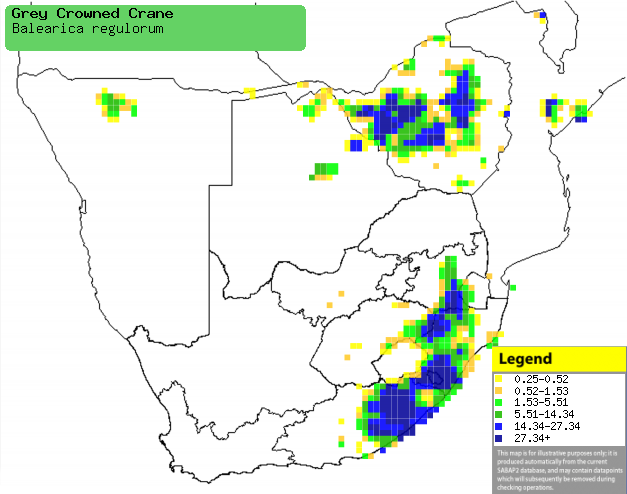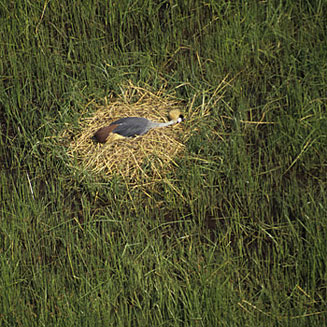|
Balearica regulorum (Grey Crowned
crane, Crowned crane)
Mahem [Afrikaans]; Ihem [Xhosa]; uNohemu [Zulu];
Engwangali [Kwangali]; Lehehemu [South Sotho]; Sekwarhandzana [Tsonga]; Leowang
[Tswana]; Grijze kroonkraan [Dutch]; Grue royale [French]; Kronenkranich
[German]; Grou-coroado-austral [Portuguese]
Life
> Eukaryotes >
Opisthokonta
> Metazoa (animals) >
Bilateria >
Deuterostomia > Chordata >
Craniata > Vertebrata (vertebrates) > Gnathostomata (jawed
vertebrates) > Teleostomi (teleost fish) > Osteichthyes (bony fish) > Class:
Sarcopterygii (lobe-finned
fish) > Stegocephalia (terrestrial
vertebrates) > Tetrapoda
(four-legged vertebrates) > Reptiliomorpha > Amniota >
Reptilia (reptiles) >
Romeriida > Diapsida > Archosauromorpha > Archosauria >
Dinosauria
(dinosaurs) > Saurischia > Theropoda (bipedal predatory dinosaurs) >
Coelurosauria > Maniraptora > Aves
(birds) >
Order: Gruiformes > Family: Gruidae
The Grey crowned crane occurs from Kenya and Uganda south to
southern Africa, where it breeds on marshes and pans, moving into cultivated
areas in the non-breeding season. It is omnivorous, feeding on a range of seeds,
leaves as well as locusts, grasshoppers, worms and small vertebrates. Its nest
is a mound of aquatic vegetation, often placed in shallow water. It lays 2-4
eggs, which are incubated for 29-31 days, by both sexes, sharing the shifts
equally. The chicks leave the nest within hours of hatching, staying in the 100
m vicinity of the nest for at least two weeks. They learn to fly when they are
56-100 days old, only becoming independent at least 120 days old.
Distribution and habitat
Occurs from Kenya and Uganda south to southern Africa,
where it is uncommon to locally common in northern Namibia, north-eastern
Botswana, Zimbabwe, central Mozambique and south-eastern South Africa. It breeds in marshes, pans and dams with fairly tall vegetation; in
the non-breeding season, it generally prefers cultivated habitats, often
pastures but also fields of maize, wheat, rice, groundnut, cabbage and cotton.
It occasionally wanders into grasslands and other
dry habitats.
|
 |
|
Distribution of Grey crowned crane in southern Africa,
based on statistical smoothing of the records from first SA Bird Atlas
Project (©
Animal Demography unit, University of
Cape Town; smoothing by Birgit Erni and Francesca Little). Colours range
from dark blue (most common) through to yellow (least common).
See here for the latest distribution
from the SABAP2. |
Parasites and parasites
- Parasites
- Haemoproteus antigonis
- Haemoproteus balaericae
- Leucocytozoon grusi
Food
It is omnivorous, feeding on a range of
seeds, leaves as well as locusts, grasshoppers, worms and small vertebrates. It
hunts animals by stamping its foot on the ground to disturb them, then plucking
them up with its bill. The following food items have
been recorded in its diet:
- Plant matter
- seeds of grasses
- Cynodon (couch grass)
- sedges
- leaves
- fallen grain
- Animals
- Invertebrates
- insects
-
Orthoptera (crickets, locusts and grasshoppers)
-
Lepidoptera
- cutworms (the larvae of certain types of moths)
- army worms (the larvae of members of Noctuidae [Owlet Moths])
-
millipedes
- crabs, especially Potamon.
- Vertebrates
- frogs
- lizards
- small rodents
- shrews
Breeding
- Monogamous, territorial solitary nester,
performing an amazing courtship display in which the male and female dance,
first bobbing their heads up and down then bowing and leaping 2-3 metres
into the air, with wings spread and legs dangling. They often pick up bits
vegetation and throw it at their partner in between each leap.
- Both sexes build the nest, which is a huge mound 1-2 metres wide. It is built with aquatic vegetation collected
nearby the nest, and is typically placed in water 8-18, rarely 200 cm deep.
It may also build its nest on dry ground just above the water level or in trees, and there are records of it using
Secretarybird
and Wattled
crane nests.
 |
|
|
Grey-crowned crane nest seen from above, Lothair,
South Africa. [photo
Warwick Tarboton ©] |
|
- Egg-laying season is highly variable from area to area, although it
usually peaks from November-January.
- It lays 2-4 eggs, which are incubated by both sexes for 29-31 days,
sharing the shifts equally. The incubating bird is very protective of its
eggs, defending them against intruders, such as juvenile
Martial eagles, humans, snake and cattle.
The adult on duty distracts either distracts the intruder by
bobbing its head, jumping and tossing objects into the air, or by attacking
it, arching its neck before leaping at the intruder, stabbing and
kicking with its beak.
- The chicks leave the nest within hours of hatching, staying in the 100 m
vicinity of the nest for at least two weeks. They learn to fly when they are
56-100 days old, only becoming independent at at least 120 days old.
Threats
Vulnerable in South Africa, largely due to habitat loss,
poisoning, deliberate snaring and hunting by dogs. Its range and abundance have
decreased in Zimbabwe, southern Mozambique and in the Eastern Cape, and it is now
common only in large protected areas.
References
-
Hockey PAR, Dean WRJ and Ryan PG (eds) 2005. Roberts
- Birds of southern Africa, VIIth ed. The Trustees of the John Voelcker
Bird Book Fund, Cape Town.
|
